Research on Tracking Technique Based on BPSK-CSK Signals
Abstract
:1. Introduction
2. Materials and Methods
2.1. Fundamentals of BPSK-CSK Signaling Theory
CSK Modulation and Demodulation
2.2. BPSK-CSK Signal Model
2.3. A BPSK-CSK Signal Tracking Method Based on Time-Division Multiplexing
2.3.1. Carrier-Tracking Loop
2.3.2. Code-Tracking Loop
2.3.3. Carrier and Code Stripping
3. Results
3.1. BER Comparison and Analysis
3.2. Tracking Error Comparison and Analysis
3.3. Verification Results
4. Discussion
Author Contributions
Funding
Data Availability Statement
Conflicts of Interest
References
- Fu, Y.; Tang, Z.; Wei, J.; Lin, M. Analysis of high-rate GNSS modulation and coding scheme based on CSK and non-binary LDPC. In Proceedings of the 12th Annual China Satellite Navigation Conference, Nanchang, China, 26–28 May 2021; pp. 1–7. [Google Scholar]
- Lopacinski, L.; Maletic, N.; Kraemer, R.; Hasani, A.; Gutiérrez, J.; Krstic, M.; Grass, E. Amplitude- and phase-modulated PSSS for wide bandwidth mixed analog-digital baseband processors in THz communication. In Proceedings of the 2023 IEEE 97th Vehicular Technology Conference (VTC2023-Spring), Florence, Italy, 20–23 June 2023; Volume 1, No. 2. pp. 1–5. [Google Scholar]
- IS-QZSS-L6-005; Quasi-Zenith Satellite System Interface Specification Centimeter Level Augmentation Service. Cabinet Office: Tokyo, Japan, 2022.
- Yan, T.; Wang, Y.; Li, T.; Tian, Y.; Qu, B.; Bian, L. MCSK Signal for LEO Satellite Constellation Based Navigation Augmentation System. In Proceedings of the China Satellite Navigation Conference (CSNC 2024), Jinan, China, 22–24 May 2024. [Google Scholar]
- Guan, L.; Xu, Z.; Tian, L.; Shi, C. Analysis and Simulation of Interference Effects on CSK Modulation Systems. In Proceedings of the 2022 15th International Congress on Image and Signal Processing, BioMedical Engineering and Informatics (CISP-BMEI), Beijing, China, 5–7 November 2022; pp. 1–7. [Google Scholar]
- Chen, X.; Luo, R.; Liu, T.; Yuan, H.; Wu, H. Satellite navigation signal authentication in GNSS: A survey on technology evolution, status, and perspective for BDS. Remote Sens. 2023, 15, 1462. [Google Scholar] [CrossRef]
- Ma, S.; Li, X.; Zou, D. A CCSK based navigation and communication integrated satellite signal. In Proceedings of the IEEE International Wireless Communications and Mobile Computing, Harbin, China, 28 June–2 July 2021; pp. 1079–1082. [Google Scholar]
- Meng, Y.; Yan, T.; Bian, L.; Wang, Y.; Tian, Y. LEO broadband satellite constellations based global navigation augmentation: Opportunity and challenge. Navig. Position Timing 2022, 9, 12–24. [Google Scholar]
- Colburn, R. Global positioning system status and modernization. In Proceedings of the 33rd International Technical Meeting of the Satellite Division of the Institute of Navigation (ION GNSS+ 2020), Online, 22–25 September 2020; The Institute of Navigation: Manassas, VA, USA, 2020; pp. 929–937. [Google Scholar]
- Reid, T.G.; Chan, B.; Goel, A.; Gunning, K.; Manning, B.; Martin, J.; Neish, A.; Perkins, A.; Tarantino, P. Satellite navigation for the age of autonomy. Proceedings of 2020 IEEE/ION Position, Location and Navigation Symposium (PLANS), Portland, OR, USA, 20–23 April 2020; IEEE: Piscataway, NJ, USA, 2020; pp. 342–352. [Google Scholar]
- Behera, P.; Siddique, A.; Delwar, T.S.; Ryu, J.-Y. Performance analysis of FIR based communication in multi user scenario using CSK. Opt. Quantum Electron. 2021, 53, 486. [Google Scholar] [CrossRef]
- Chatre, E.; Benedicto, J. Galileo programme update. In Proceedings of the 33rd International Technical Meeting of the Satellite Division of the Institute of Navigation (ION GNSS+ 2020), Online, 22–25 September 2020; The Institute of Navigation: Manassas, VA, USA, 2020; pp. 950–977. [Google Scholar]
- Shen, J.; Geng, C. Update on the beidou navigation satellite system (bds). In Proceedings of the 33rd International Technical Meeting of the Satellite Division of the Institute of Navigation (ION GNSS+ 2020), Online, 22–25 September 2020; The Institute of Navigation: Manassas, VA, USA, 2020; pp. 978–1015. [Google Scholar]
- Liu, X.; Ba, X.; Jie, C.; Li, M.; Qi, X. Algorithm for non-orthogonal code shift keying and code index modulation. Syst. Eng. Electron. 2021, 43, 232–236. [Google Scholar]
- Pena, A.G.; Julien, O.; Anghileri, M. Multipurpose TDM component for GNSS. In Proceedings of the 31th International Technical Meetings of the ION Satellite Division (ION GNSS+ 2018), Miami, FL, USA, 24–28 September 2018; pp. 943–962. [Google Scholar]
- Zou, D.; Li, X.; Ma, R. A signal optimization strategy for next generation navigation and communication integration applications. Phys. Commun. 2022, 50, 101510. [Google Scholar] [CrossRef]
- Delwar, T.S.; Siddique, A.; Biswal, M.R.; Rashed, A.N.Z.; Jana, A.; Ryu, J.Y. Novel Multi-user MC-CSK Modulation Technique in Visible Light Communication. Opt. Quantum Electron. 2021, 53, 196. [Google Scholar] [CrossRef]
- Rui, X.; Ruan, H. Low-complexity iterative detection algorithm in LDPC-CSK scheme for high-speed GNSS. In Proceedings of the 9th International Conference on Networks, Communication and Computing, (ICNCC 2020), Online, 18–20 December 2020. [Google Scholar]
- Komuro, N.; Habuchi, H. Impact of systematically constructed nonorthogonal code shift keying for optical code division multiple access. OSA Contin. 2023, 2, 131–142. [Google Scholar] [CrossRef]
- Jing, L.; He, C.; Wang, H.; Zhang, Q.; Yin, H. A New IDMA System Based on CSK Modulation for Multiuser Underwater Acoustic Communications. IEEE Trans. Veh. Technol. 2020, 69, 3080–3092. [Google Scholar] [CrossRef]
- Koshimoto, M.; Kozawa, Y.; Habuchi, H. Theoretical analysis of underwater simultaneous light Information and power transfer using inverted N parallel code shift keying with power splitting receiver. In Proceedings of the 2023 IEEE International Symposium on Circuits and Systems (ISCAS), Monterey, CA, USA, 21–25 May 2023. [Google Scholar]
- Yan, T.; Wang, Y.; Liu, X.; Bian, L.; Meng, Y. Research on MPSK Modulation Based GNSS Signals with High Data Rate. In Proceedings of the 2020 China Satellite Navigation Conference, Chengdu, China, 22–25 November 2020; Springer: Singapore, 2020; pp. 474–484. [Google Scholar]
- Ortega, L.; Vilà-Valls, J.; Poulliat, C.; Closas, P. GNSS Data Demodulation over Fading Environments: Antipodal and M-ary CSK Modulations. IET Radar Sonar Navig. 2021, 15, 113–127. [Google Scholar] [CrossRef]
- Cho, H.; Song, H.-Y.; Ahn, J.M.; Lim, D.W. Some New RS-coded Orthogonal Modulation Schemes for Future GNSS. ICT Express 2021, 7, 530–534. [Google Scholar] [CrossRef]
- Chauvat, R.; Garcia-Pena, A.; Paonni, M. On efficient and low-complexity decoding of binary LDPC-coded CSK signals for GNSS links with increased data rates. Proceedings of 2020 IEEE/ION Position, Location and Navigation Symposium, Portland, OR, USA, 20–23 April 2020. [Google Scholar]
- Chen, Y.; Wang, D.; Chen, S.; Ma, W.; Li, D.; Dong, Q. Research on receiving method of code shift keying (CSK) signal. Proceedings of 11th China Satellite Navigation Conference (CSNC), Chengdu, China, 22–25 November 2020; pp. 298–309. [Google Scholar]
- Yan, T.; Wang, Y.; Li, T.; Tian, Y.; Bian, L.; Meng, Y. Low complexity acquisition and tracking methods for CSK modulated signals. In Proceedings of the China Satellite Navigation Conference (CSNC 2021) Proceedings, Nanchang, China, 22–25 May 2021; Springer: Berlin/Heidelberg, Germany, 2021; Volume III, pp. 193–202. [Google Scholar]
- Yan, T.; Tian, Y.; Li, T.; Wang, G.; Wang, Y.; Zhou, Q.; Bian, L. Tracking method for code shift keying(CSK) modulated signal. Chin. Space Sci. Technol. 2023, 43, 117–127. [Google Scholar]
- Li, Y.; Zhou, G.; Xiao, L.; Chen, H. An Efficient Demodulation Algorithm for CSK Modulated Signals Based on Block FFT. Radio Eng. 2023, 53, 1321–1327. [Google Scholar]
- Li, Y.; Zhou, G.; Xiao, L.; Chen, H. An efficient demodulation algorithm for CSK modulated signals based on partial output FFT. Gnss World China 2022, 47, 73–78. [Google Scholar]
- He, X.; Liu, C.; Wang, W.; Li, J.; Liu, X.; Yang, Y.; Ba, X.; Chen, J. The design of Galileo E6B/C receiver. Appl. Electron. Tech. 2020, 46, 8–11+17. [Google Scholar]




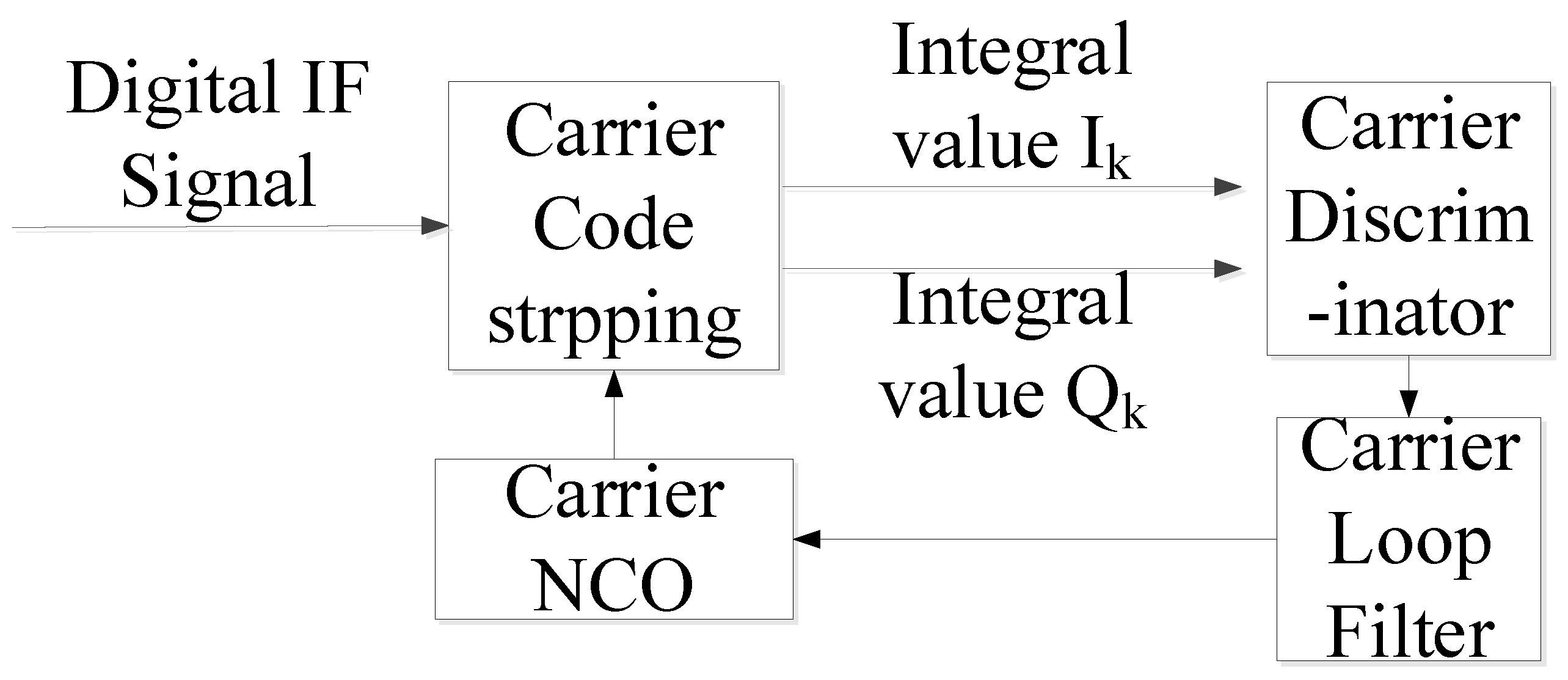
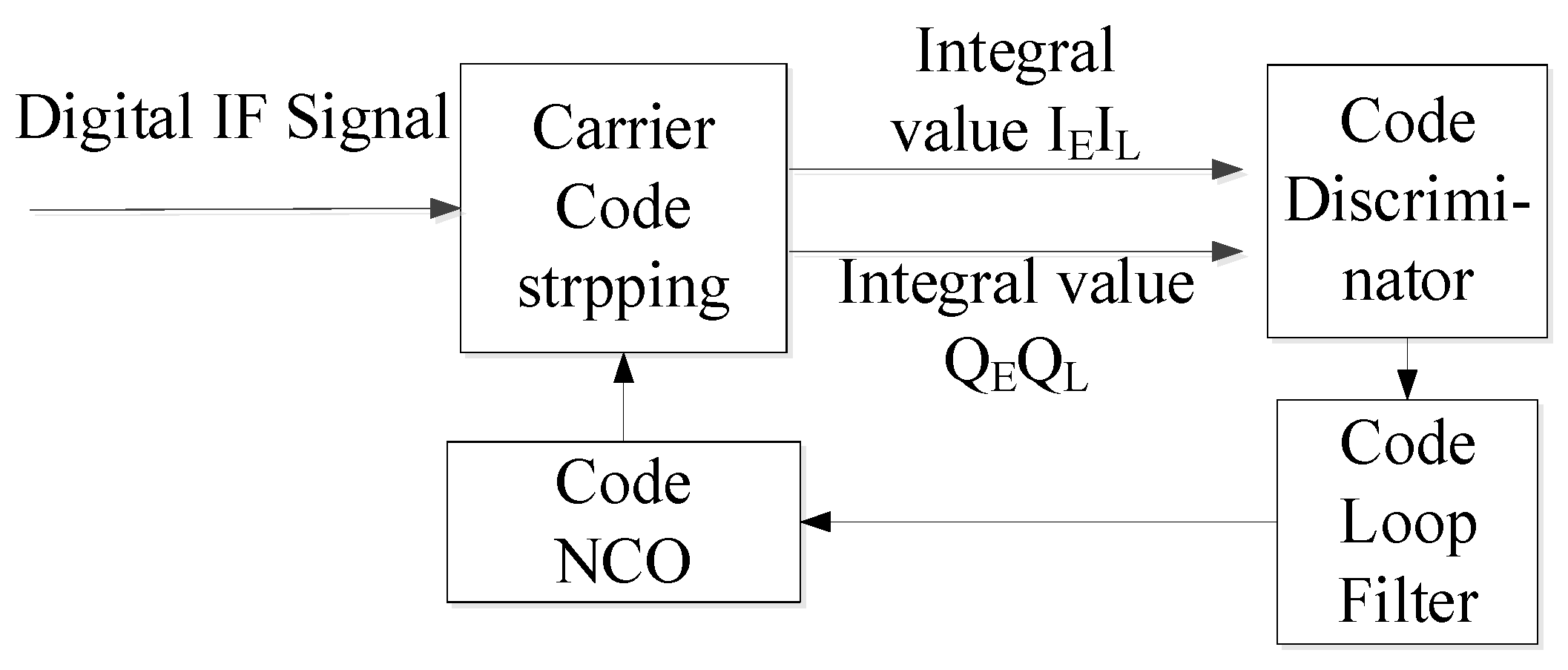
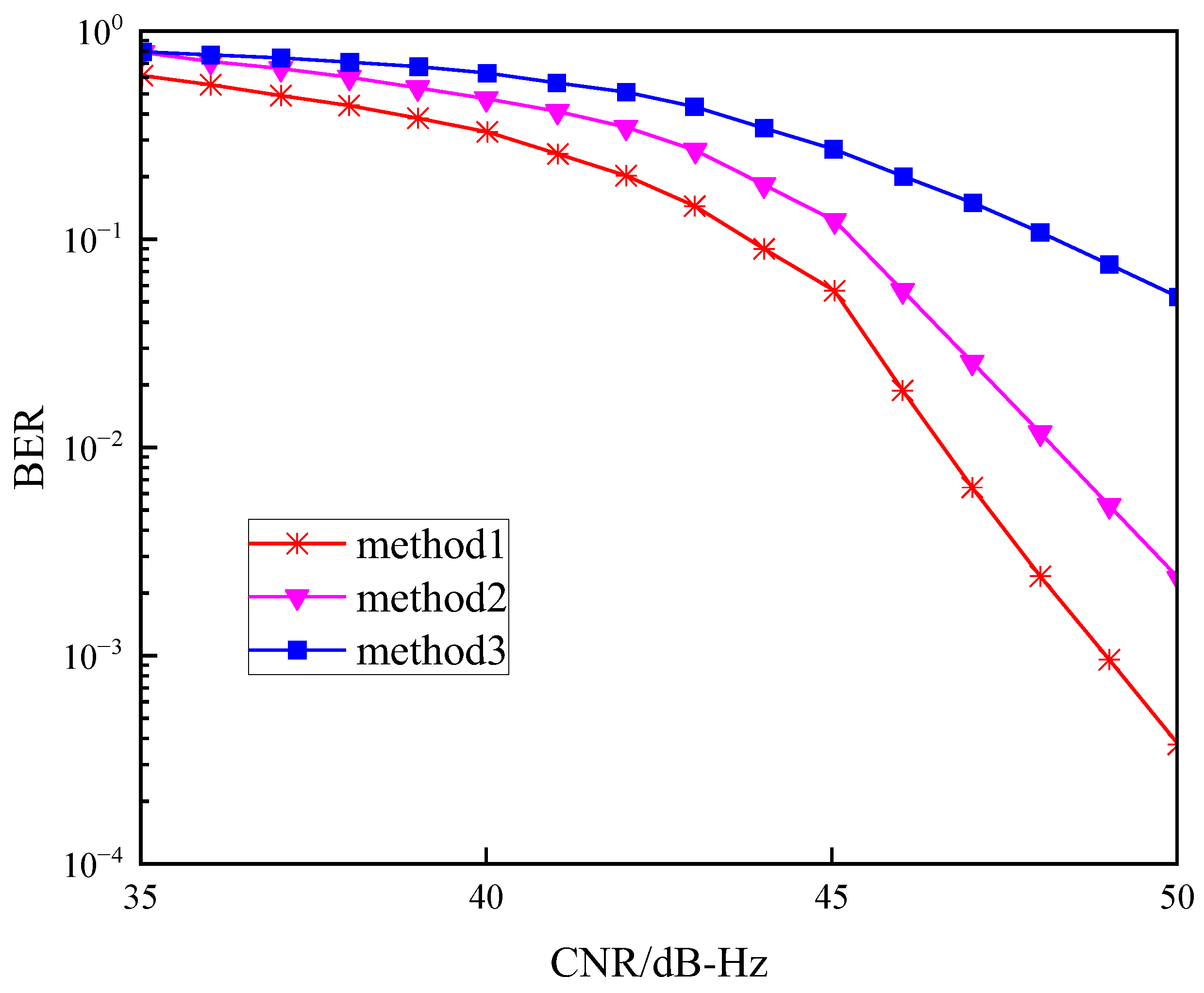


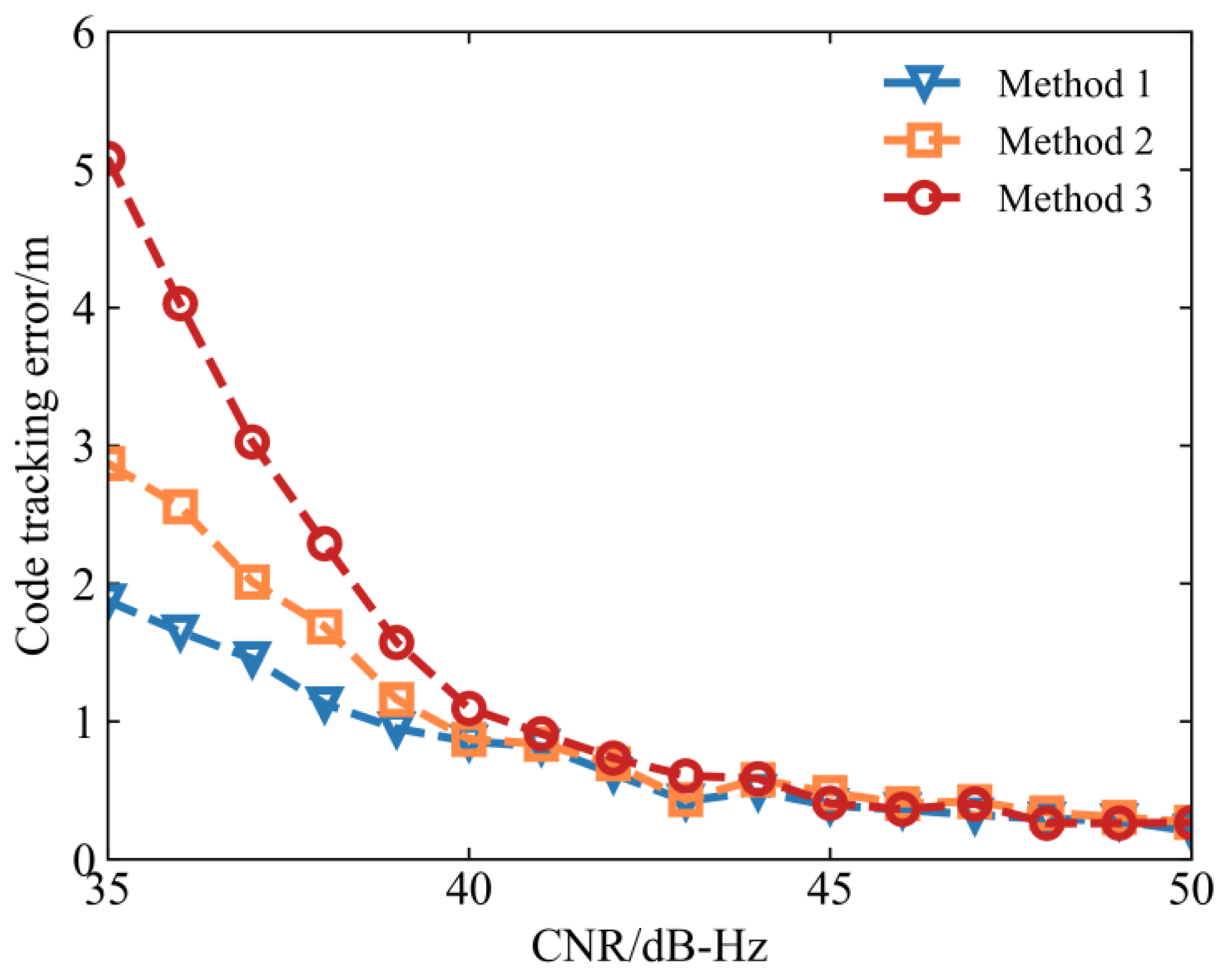
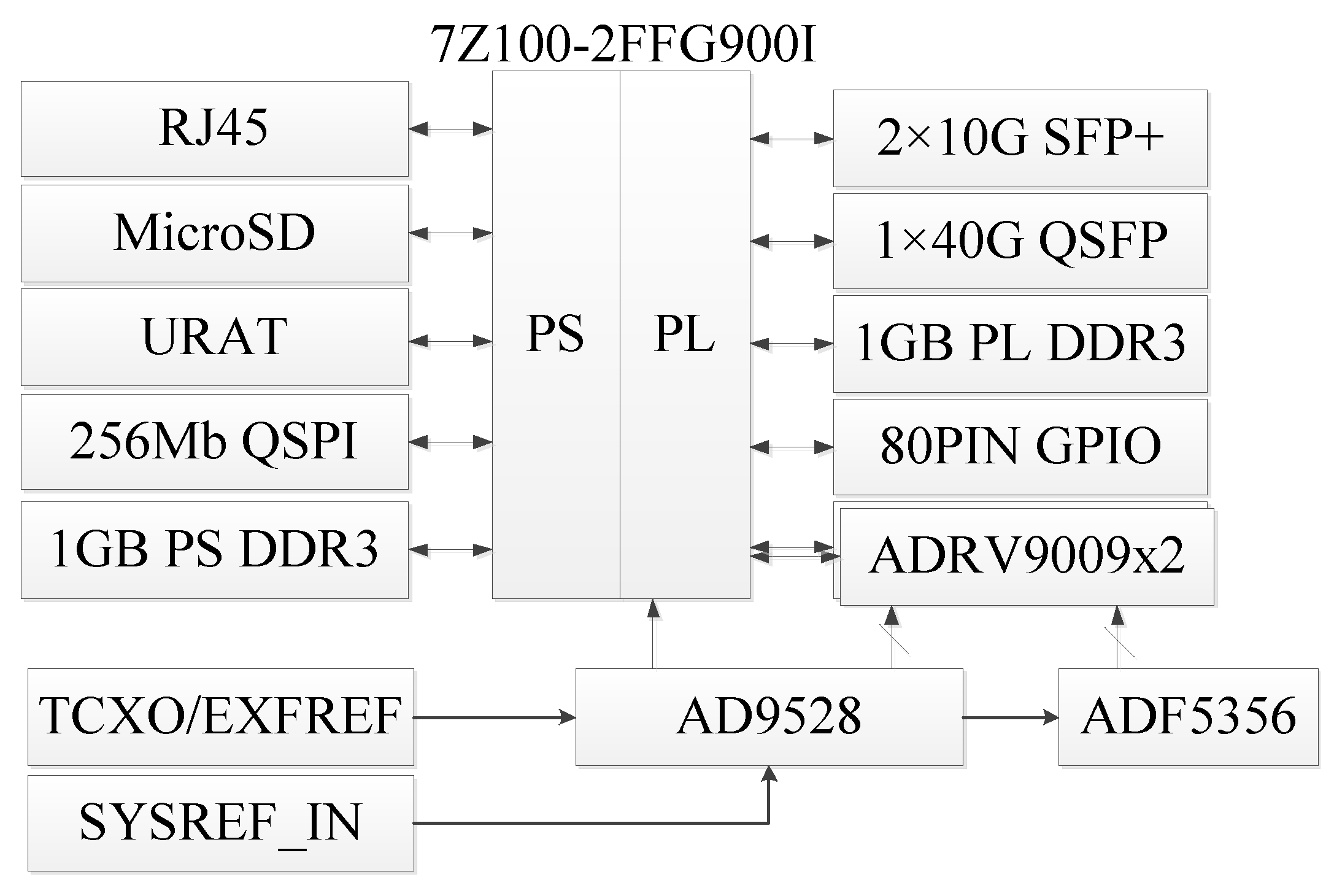

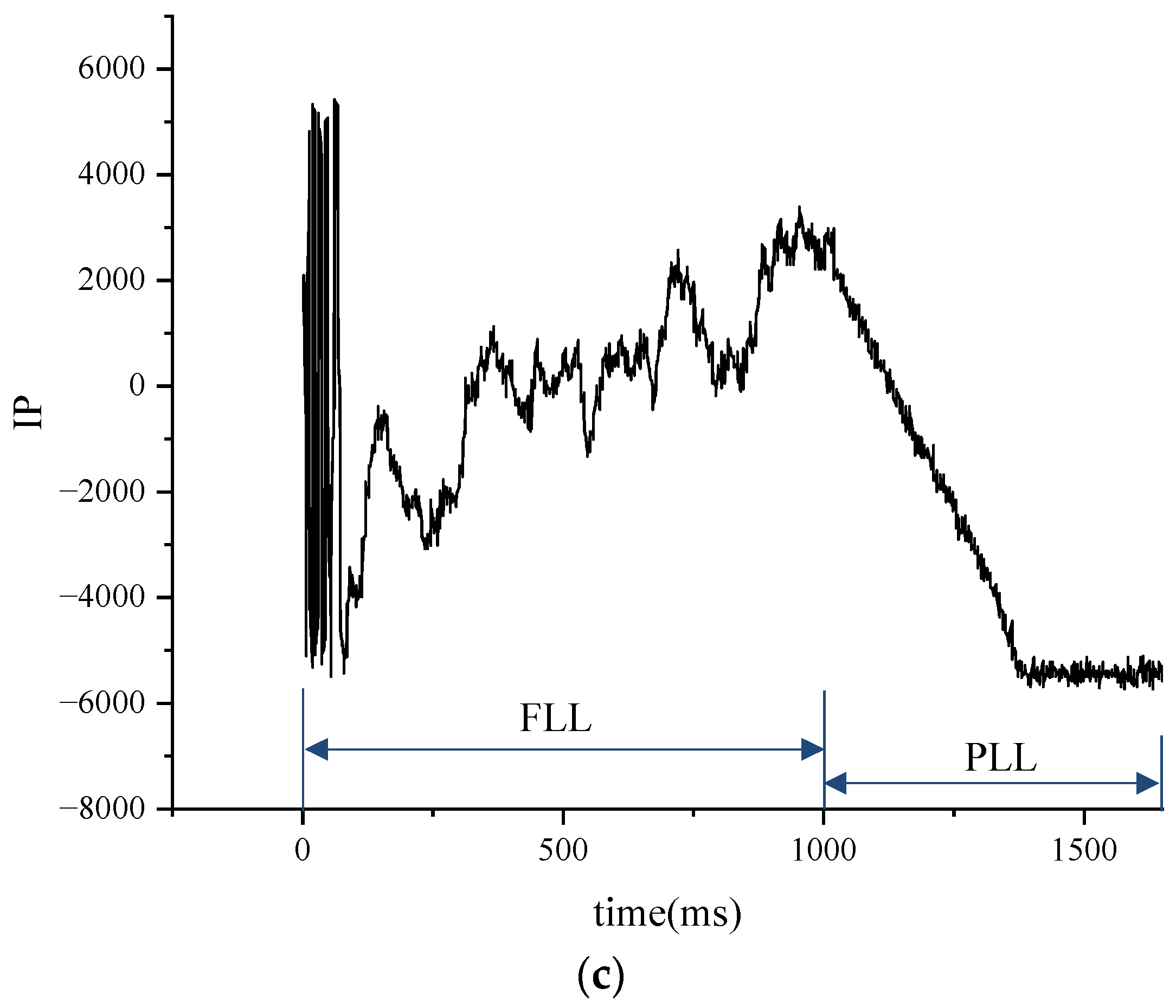
| Coherent Integration Time/ms | Non-Coherent Integration Time/ms | Traction Range/Hz | Loop Bandwidth/Hz |
|---|---|---|---|
| 4 | 1 | ±62.5 | 20 |
| Coherent Integration Time/ms | Non-Coherent Integration Time/ms | Code Spacing of E,L/Code-Chip | Loop Bandwidth/Hz |
|---|---|---|---|
| 4 | 1 | 1 | 2 |
| CNR/(dB-Hz) | Method 3 Higher than Method 1/% | Method 2 Higher than Method 1/% |
|---|---|---|
| 36 | 36.00 | 18.42 |
| 37 | 35.41 | 18.99 |
| 38 | 34.79 | 19.56 |
| 39 | 34.19 | 20.12 |
| 40 | 32.82 | 16.24 |
| 41 | 31.61 | 12.39 |
| 42 | 30.47 | 8.53 |
| 43 | 29.24 | 4.67 |
| 44 | 25.43 | 3.85 |
| 45 | 21.12 | 3.11 |
| 46 | 17.56 | 2.31 |
| 47 | 13.31 | 1.52 |
| 48 | 10.54 | 1.15 |
| 49 | 7.27 | 0.78 |
| 50 | 4.15 | 0.41 |
| CNR/(dB-Hz) | Method 3 Higher than Method 1/% | Method 2 Higher than Method 1/% |
|---|---|---|
| 36 | 27.72 | 16.38 |
| 37 | 28.67 | 15.44 |
| 38 | 29.59 | 14.49 |
| 39 | 30.63 | 13.54 |
| 40 | 28.49 | 11.88 |
| 41 | 26.27 | 10.23 |
| 42 | 24.09 | 8.57 |
| 43 | 21.92 | 6.91 |
| 44 | 19.55 | 5.53 |
| 45 | 17.28 | 4.16 |
| 46 | 14.92 | 2.79 |
| 47 | 12.59 | 1.42 |
| 48 | 10.12 | 1.12 |
| 49 | 7.65 | 0.81 |
| 50 | 5.18 | 0.51 |
Disclaimer/Publisher’s Note: The statements, opinions and data contained in all publications are solely those of the individual author(s) and contributor(s) and not of MDPI and/or the editor(s). MDPI and/or the editor(s) disclaim responsibility for any injury to people or property resulting from any ideas, methods, instructions or products referred to in the content. |
© 2024 by the authors. Licensee MDPI, Basel, Switzerland. This article is an open access article distributed under the terms and conditions of the Creative Commons Attribution (CC BY) license (https://creativecommons.org/licenses/by/4.0/).
Share and Cite
Chen, Y.; Cheng, J.; Li, X.; Bai, X.; Nie, Z. Research on Tracking Technique Based on BPSK-CSK Signals. Electronics 2024, 13, 1517. https://doi.org/10.3390/electronics13081517
Chen Y, Cheng J, Li X, Bai X, Nie Z. Research on Tracking Technique Based on BPSK-CSK Signals. Electronics. 2024; 13(8):1517. https://doi.org/10.3390/electronics13081517
Chicago/Turabian StyleChen, Yuxin, Jie Cheng, Xiaodong Li, Xue Bai, and Zhixi Nie. 2024. "Research on Tracking Technique Based on BPSK-CSK Signals" Electronics 13, no. 8: 1517. https://doi.org/10.3390/electronics13081517





